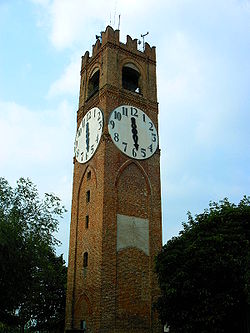Monsvici
| Mondovì | |
|---|---|
| Comune | |
| Città di Mondovì | |

Belvedere Tower
|
|
| Location of Mondovì in Italy | |
| Coordinates: 44°23′20″N 7°49′5″E / 44.38889°N 7.81806°ECoordinates: 44°23′20″N 7°49′5″E / 44.38889°N 7.81806°E | |
| Country | Italy |
| Region | Piedmont |
| Province | Cuneo (CN) |
| Frazioni |
|
| Government | |
| • Mayor | Stefano Viglione (PdL) |
| Area | |
| • Total | 87 km2 (34 sq mi) |
| Elevation | 395 m (1,296 ft) |
| Population (31 January 2009) | |
| • Total | 22,577 |
| • Density | 260/km2 (670/sq mi) |
| Demonym(s) | Monregalesi (rarer Mondoviti) |
| Time zone | CET (UTC+1) |
| • Summer (DST) | CEST (UTC+2) |
| Postal code | 12040 |
| Dialing code | 0173 |
| Patron saint | St. Donatus |
| Saint day | 30 October |
| Website | www |
Mondovì (Italian pronunciation: [mondoˈvi]; Piemontese: Ël Mondvì [əl mʊndˈvi], Latin: Mons Regalis) is a town and comune (township) in Piedmont, northern Italy, about 80 kilometres (50 mi) from Turin. The area around it is known as the Monregalese.
The town, located on the Monte Regale hill, is divided into several rioni (ancient quarters): Piazza (the most ancient), Breo, Pian della Valle, Carassone, Altipiano, Borgato and Rinchiuso, lower, next to the Ellero stream, developed from the 18th century when industries developed in Mondovì and when it was reached by the railway.
The Funicolare di Mondovì, a recently reopened funicular railway in the town, links Breo with Piazza.
It is the seat of the Roman Catholic Diocese of Mondovì. It is also the home of the Academia Montis Regalis orchestra led by conductor Alessandro De Marchi.
Founded on a hilltop in 1198 by survivors of the destroyed village of Bredolo and by inhabitants of the neighboring villages of Vico (now Vicoforte), Vasco (now Monastero di Vasco) and Carassone (which was abandoned after the founding of the new city): an independent comune named Ël Mont ëd Vi, meaning "The Mount of Vico" in Piedmontese, was formed.
Their independence proved to be short-lived because the bishop of Asti and the marquis of Ceva stormed it in 1200 and destroyed it in 1231. The commune resisted, however, and the following year it was able to sustain another attack from Asti. In 1260 it was occupied by Charles I of Anjou (then King of Naples and one of the most powerful landlords in Provence and north-western Italy), while in 1274 it returned under the bishops of Asti. In 1290 he was however able to buy back its communal independence, under the new name of Mons Regalis ("Royal Mount") due to its large privileges. In 1305 it fell again under the Angevins, followed by the Visconti, the Marquisate of Montferrat, the Acaja and, from 1418, the House of Savoy.
...
Wikipedia

